NVIDIA GeForce GTX 770 Review: The $400 Fight
by Ryan Smith on May 30, 2013 9:00 AM ESTPower, Temperature, & Noise
As always, last but not least is our look at power, temperature, and noise. Next to price and performance of course, these are some of the most important aspects of a GPU, due in large part to the impact of noise. All things considered, a loud card is undesirable unless there’s a sufficiently good reason – or sufficiently good performance – to ignore the noise.
GTX 770 ends up being an interesting case study in all 3 factors due to the fact that NVIDIA is pushing the GK104 GPU so hard. Though the old version of GPU Boost muddles things some, there’s no denying that higher clockspeeds coupled with the higher voltages needed to reach those clockspeeds has a notable impact on power consumption. This makes it very hard for NVIDIA to stick to their efficiency curve, since adding voltages and clockspeeds offers diminishing returns for the increase in power consumption.
| GeForce GTX 770 Voltages | ||||
| GTX 770 Max Boost | GTX 680 Max Boost | GTX 770 Idle | ||
| 1.2v | 1.175v | 0.862v | ||
As we can see, NVIDIA has pushed up their voltage from 1.175v on GTX 680 to 1.2v on GTX 770. This buys them the increased clockspeeds they need, but it will drive up power consumption. At the same time GPU Boost 2.0 helps to counter this some, as it will keep leakage from being overwhelming by keeping GPU temperatures at or below 80C.
| GeForce GTX 770 Average Clockspeeds | |||
| Max Boost Clock | 1136MHz | ||
| DiRT:S |
1136MHz
|
||
| Shogun 2 |
1136MHz
|
||
| Hitman |
1136MHz
|
||
| Sleeping Dogs |
1102MHz
|
||
| Crysis |
1136MHz
|
||
| Far Cry 3 |
1136MHz
|
||
| Battlefield 3 |
1136MHz
|
||
| Civilization V |
1136MHz
|
||
| Bioshock Infinite |
1128MHz
|
||
| Crysis 3 |
1136MHz
|
||
Speaking of clockspeeds, we also took the average clockspeeds for GTX 770 in our games. In short, GTX 770 is almost always at its maximum boost bin of 1136; the oversized Titan cooler keeps temperatures just below the thermal throttle, and there’s enough TDP headroom left that the card doesn’t need to pull back to avoid that. This is one of the reasons why GTX 770’s performance advantage over GTX 680 is greater than the clockspeed increases alone.
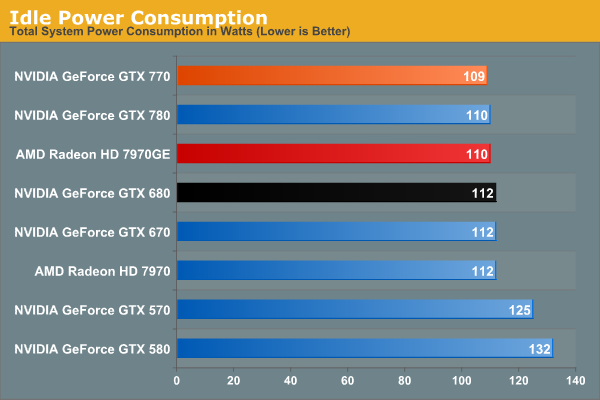
We don’t normally publish this data, but GTX 770 has an extra interesting attribute about it: its idle clockspeed is lower than other Kepler parts. GTX 680 and GTX 780 both idle at 324MHz, but GTX 770 idles at 135MHz. Even 324MHz has proven low enough to keep Kepler’s idle power in check in the past, so it’s not entirely clear just what NVIDIA is expecting here. We’re seeing 1W less at the wall, but by this point the rest of our testbed is drowning out the video card.
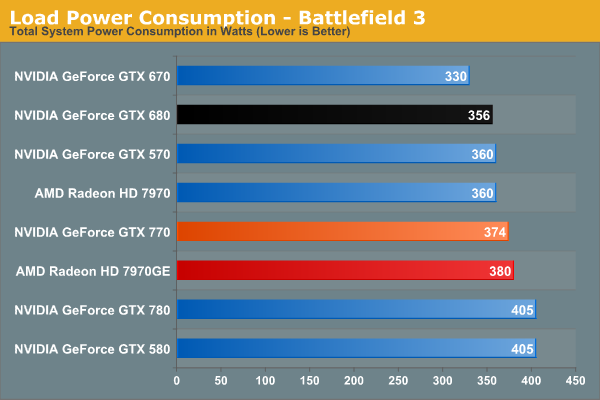
Moving on to BF3 power consumption, we can see the power cost of GTX 770’s performance. 374W at the wall is only 18W more than GTX 680, thanks in part to the fact that GTX 770 isn’t hitting its TDP limit here. At the same time compared to the outgoing GTX 670, this is a 44W difference. This makes it very clear that GTX 770 is not a drop-in replacement for GTX 670 as far as power and cooling go. On the other hand GTX 770 and GTX 570 are very close, even if GTX 770’s TDP is technically a bit higher than GTX 570’s.
Despite this runup, GTX 770 still stays a hair under 7970GE, despite the slightly higher CPU power consumption from GTX 770’s higher performance in this benchmark. It’s only 6W at the wall, but it showcases that NVIDIA didn’t have to completely blow their efficiency curve to get a GK104 card back up to 7970GE performance levels.
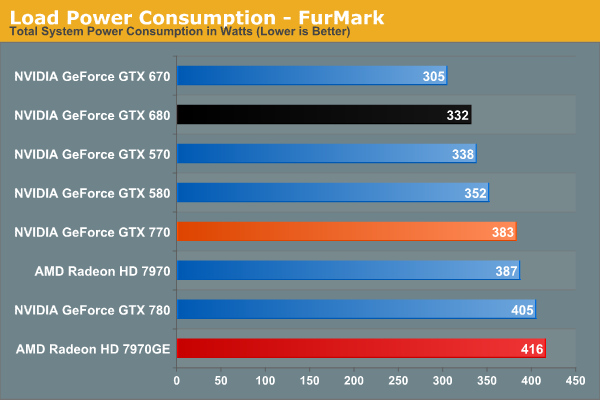
In our TDP constrained scenario we can see the gaps between our cards grow. 78W separates the GTX 770 from GTX 670, and even GTX 680 draws 41W less, almost exactly what we’d expect from their published TDPs. On the flip side of the coin 383W is still less than both 7970 cards, reflecting the fact that GTX 770 is geared for 230W while AMD’s best is geared for 250W.
This is also a reminder however that at a mid-generation product extra performance does not come for free. With the same process and the same architecture, performance increases require power increases. This won’t significantly change until we see 20nm cards next year.
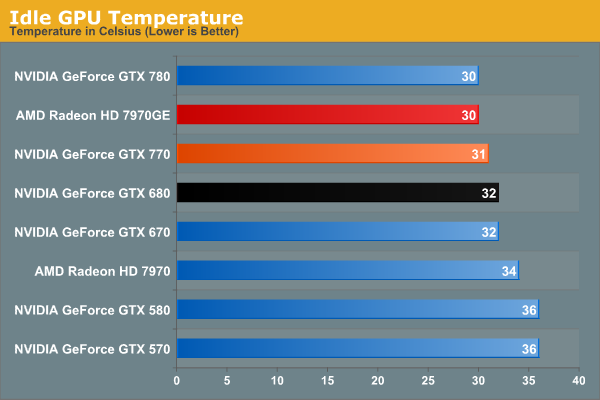
Moving on to temperatures, these are going to be a walk in the part for the reference GTX 770 due to the Titan cooler. At idle we see it hit 31C, which is actually 1C warmer than GTX 780, but this really just comes down to uncontrollable variations in our tests.
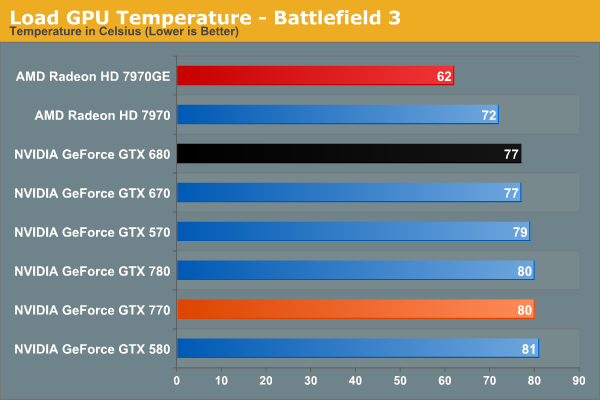
As a GPU Boost 2.0 card temperatures will top out at 80C in games, and that’s exactly what happens here. Interestingly, GTX 770 is just hitting 80C, as evidenced by our clockspeeds earlier. If it was running hotter, it would have needed to drop to lower clockspeeds.
Of course it doesn’t hold a candle here to 7970GE, but that’s the difference between a blower and an open air cooler in action. The blower based 7970 is much closer, as we’d expect.
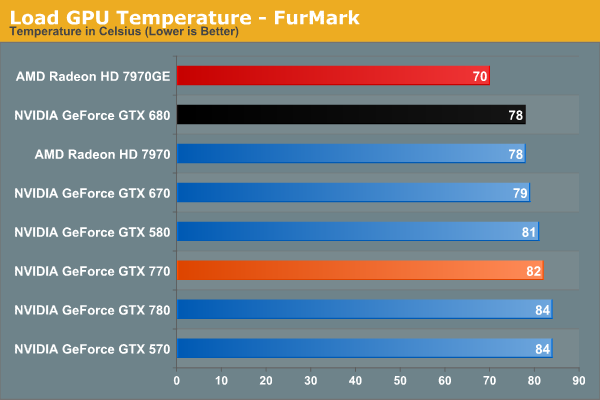
Under FurMark the temperature situation is largely the same. The GTX 770 comes up to 82C here (favoring TDP throttling over temperature throttling), but the relative rankings are consistent.
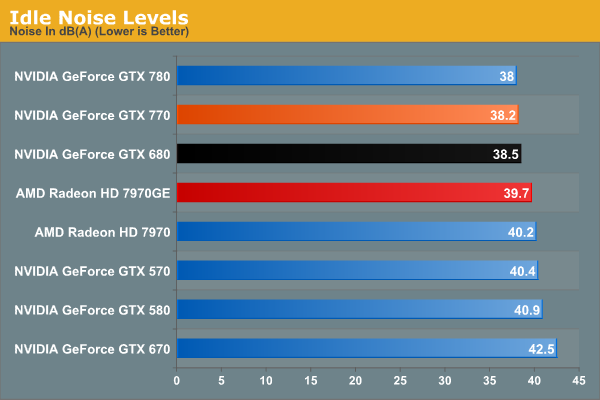
With Titan’s cooler in tow, idle noise looks very good on GTX 770.
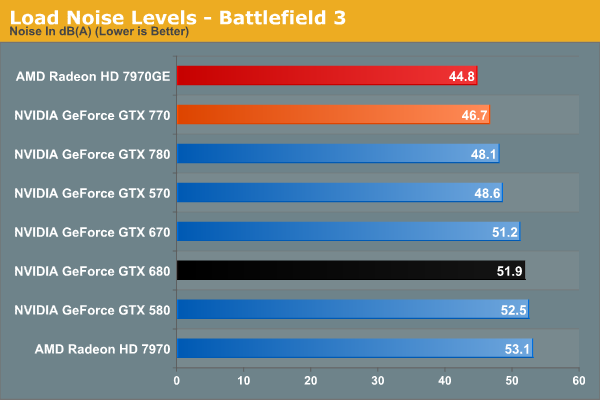
Our noise results under Battlefield 3 are a big part of the reason we’ve been calling the Titan cooler oversized for GTX 770. When is the last time we’ve seen a blower on a 230W card that only hit 46.7dB? The short answer is never. GTX 770’s fan simply doesn’t have to rev up very much to handle the lesser heat output. In fact it’s damn near competitive with the open air cooled 7970GE; there’s still a difference, but it’s under 2dB. More importantly however, despite being a more powerful and more power-hungry card than the GTX 680, the GTX 770 is over 5dB quieter, and this is despite the fact that the GTX 680 is already a solid card own its own. Titan’s cooler is certainly expensive, but it gets results.
Of course this is why it’s all the more a shame that none of NVIDIA’s partners are releasing retail cards with this cooler. There are some blowers in the pipeline, so it will be interesting to see if they can maintain Titan’s performance while giving up the metal.
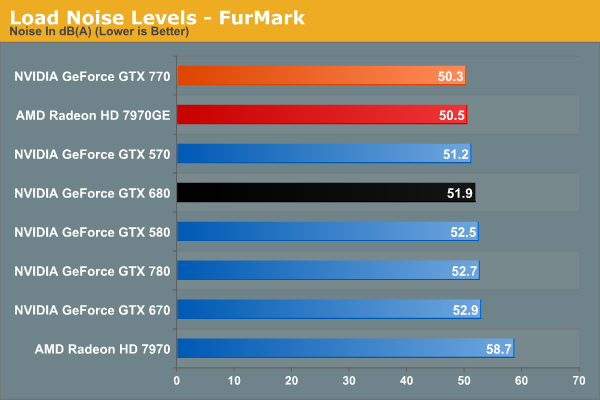
With FurMark pushing our GTX 770 at full TDP, our noise results are still good, but not as impassive as they were under BF3. 50.3dB is still over a dB quieter than GTX 680, though obviously much closer than before. On the other hand the GTX 770 ever so slightly edges out the 7970GE and its open air cooler. Part of this comes down to the TDP difference of course, but beating an open air cooler like that is still quite the feat.
Wrapping things up here, it will be interesting to see where NVIDIA’s partners go with their custom designs. GTX 770, despite being a higher TDP part than both GTX 670 and GTX 680, ends up looking very impressive when it comes to noise, and it would be great to see NVIDIA’s partners match that. At the same time the increased power consumption and heat generation relative to the GeForce 600 series is unfortunate, but not unexpected. But for buyers coming from the GeForce 400 and GeForce 500 series, GTX 770 is in-line with what those previous generation cards were already pulling.










117 Comments
View All Comments
djboxbaba - Thursday, May 30, 2013 - link
I'd say thats a good choice for the 1440p monitor. As far as the actual card, I agree with you that your decision should be between those 2 cards. Just as performance of the 7970GHz has increased due to driver updates, I think we can expect some performance increase from the 770 over time as well. Not sure why that was not mentioned at all in the article. If i were in your situation it would probably come down to the bundled games that come with the AMD card, do you want those games?yasamoka - Thursday, May 30, 2013 - link
No, we cannot expect performance increases from the 770 over time due to driver updates. The 770 is GK104, same architecture as the GTX680. It's just a higher-clocked 680. 680 drivers have been rolling since its release in March, it's been 14 months.The regular game-specific performance improvements will be there for both cards, for games that are coming, but we can't expect the 770 to improve in performance due to drivers as it is already a 14-month mature product (refresh), driver-wise.
EJS1980 - Thursday, May 30, 2013 - link
That makes no sense. If the 7970 has been benefiting greatly from each driver update, and its almost 6 months older than GK104, why can the 7970 improve but the 770 can't?Galidou - Saturday, June 1, 2013 - link
Wow that's a real lack of information to come up with an answer like this. 7970 was a COMPLETE remake of what had been done before. Totally justifiable that drivers improved performance like the gtx 600 series that was new. The 770 is TOTALLY a 680, physically, it's simply a GK 104 die pushed to the extreme, almost nothing new on the driver side from 680 to 770. Not that they can't improve anything but most of the job is done on the driver side of things.Stuka87 - Thursday, May 30, 2013 - link
Did you mean to say 7970Ghz? The 7950 is already at $300, has been for some time.joel4565 - Thursday, May 30, 2013 - link
Yeah I did mean 7970Ghz. Sorry for confusion.EJS1980 - Thursday, May 30, 2013 - link
I'd say forget the Dell, and go with an Overlord Tempest OC. It's the same price & panel as you'd get from Dell, except it can be overclocked to 120hz. They're a California based company, and their sales/IT departments are awesome. If you're not interested in overclocking, they sell a 60hz model for about $400. You should seriously check them out.cbrownx88 - Friday, May 31, 2013 - link
I went to their page and everything is sold out... :(Hrel - Thursday, May 30, 2013 - link
Pretty happy to see Nvidia FINALLY realize the potential of this architexture. Gives me hope for the next generation; combined with a process node drop we should see pretty impressive performance. This refresh will keep the market feeling fresh until then. I just hope they're a lot more aggressive with pricing. I know you say in the article that you were surprised by this price; but really it's still too high. It's not absurd or anything, and assuming the price drops 50+ bucks by fall it's in line with GPU market trends. But I'd like to see some price pressure FROM Nvidia, instead of AMD always being the one to kick off a price war.trajan2448 - Thursday, May 30, 2013 - link
Most of the reviews I've seen have had the 770 beating the 7970gE pretty well. It seems this site really bends over to make AMD look as good as possible, even though the 7970 uses more power and is generally slower and more expensive.